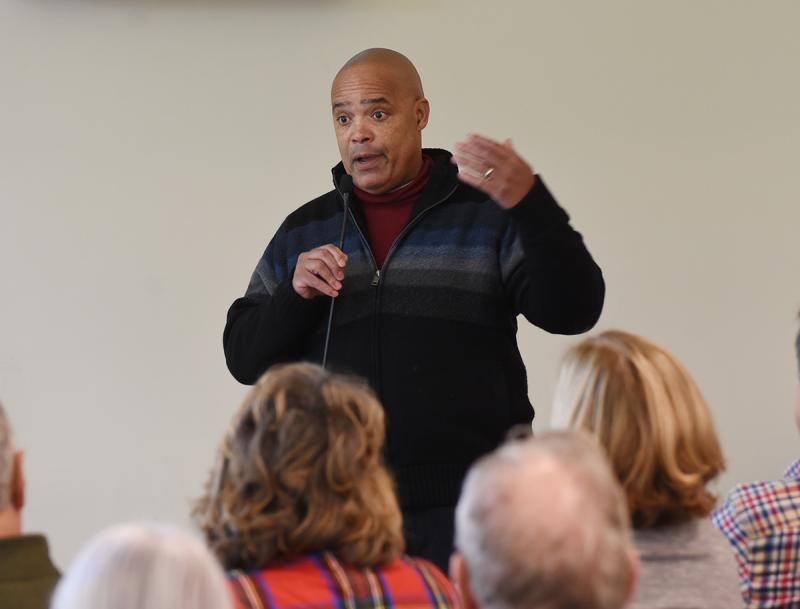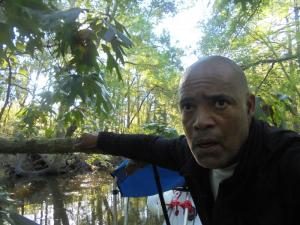Atlantic rower seeks commemoration for Harriet Tubman
After rowing north through the Delmarva Peninsula nearing the end of a 5,000-mile journey by boat from West Africa, Don Victor Mooney’s thoughts turned to Harriet Tubman.
As she led slaves to freedom, she often used the same waters to travel north through Virginia, Maryland and eventually Delaware.
Now, on the 400th anniversary of the arrival of the first slave ship in the United States, the 54-year-old New York man is seeking to rename the Virginia Inside Passage to the Harriet Tubman Waterway.
“It’s only fitting that we reflect on her past and encourage the next generation to learn about this strong woman,” he said during a Nov. 16 event at the Lewes History Museum. “Our girls need this. They could be future presidents and first ladies. The time we have now is a time for healing.”
Mooney was the first African-American to cross the Atlantic Ocean by way of row boat, following a similar path as African slaves. He was inspired to do it in honor of his brother, who died of HIV/AIDS. The goal was to raise awareness and encourage people to get tested.
“My thinking was if I can row across the Atlantic Ocean, someone can go to a clinic and get tested,” he said. “Yes, there are life-saving medications that are allowing people to live, but prevention is necessary.”
The journey was anything but easy. His first two attempts to leave from Senegal – from where he says his ancestors departed – failed. In 2006, his first trip in a homemade boat lasted just 30 minutes. “People didn’t know whether to laugh or cry,” he said.
On his second attempt in 2009, he used a boat manufactured in Trappe, Md. He quickly learned the ocean current took him too far south, leading him toward Brazil.
On his third attempt in 2011, he left from Cape Verde, west of Senegal, but within hours of departing the boat started taking on water. The wind took him west away from Africa, so he was unable to row back. He was forced into a lifeboat, floating in the Atlantic Ocean for two weeks.
Just two days after abandoning his boat, a large vessel came upon him. He screamed for help. Someone came out, looked at him and continued on. “I cried like a baby because I didn’t want to die,” he said.
He then turned to a wet and soggy Bible he brought along. It was Psalm 91, which says, “He is my refuge and my fortress, my God, in whom I trust.” That changed his life.
After reading the passage, he said, God spoke to him. “I had a divine intervention,” he said, claiming he heard God say “my son.” “After that, I was fine.”
For his fourth attempt, he departed in February 2014 from the Canary Islands off the coast of Morocco. It took him 129 days to reach St. Martin in the Caribbean. On this attempt, he ran out of food and lost 80 pounds, was attacked by an oceanic white tipshark, and had his 24-foot boat hijacked by Haitian pirates.
Despite the obstacles, he achieved his goal in November 2015, completing his journey at the Brooklyn Bridge – he spent several weeks in the hospital after reaching St. Martin, then took several months off after his boat was stolen and damaged by pirates.
Several times during his journey he relied on the kindness of others. While crossing the Atlantic, he had a support team of doctors and meteorologists helping him. After his boat was stolen by pirates, the U.S. Coast Guard recovered the damaged vessel and shipped it to Miami.
In Delaware, he called upon Sussex Countians to clear the Assawoman Canal after a hurricane blocked his path. In Lewes, the late Joe Morris of Lewes Harbour Marina helped him when he arrived with infected feet.
It all reminded Mooney of the help Tubman received on her journeys. “When Harriet was going through the Underground Railroad and made stops, they’d give her a blanket, some coffee or allow her to rest,” Mooney said. “They’d say ‘we know you have a mission you have to complete. We’re going to help you reach that finish line.’”
His current efforts are being made possible by the H.R. 1242 Resilience Project, named after a law signed by the president earlier this year. It provides funding for programs and events commemorating, honoring and recognizing the contributions of African-Americans.
Earlier this year, Mooney traveled to Goree Island, Senegal, and retrieved a stone from the House of Slaves, once a holding center for African slaves. In October, he placed the stone at Tubman’s grave in Auburn, N.Y., in honor of her resilience and as a gesture of healing. The stone was donated to the State of New York.
He also traveled to the Middle East earlier this year to honor the men and women who serve the country.
To learn more about the H.R. 1242 Resilience Project or to sign a petition to change the name of the Virginia Inside Passage, go to hr1242resilience.com.
Nick Roth is the news editor. He has been with the Cape Gazette since 2012, previously covering town beats in Milton and Lewes. In addition to serving on the editorial board and handling page layout, Nick is responsible for the weekly Delaware History in Photographs feature and enjoys writing stories about the Cape Region’s history. Prior to the Cape Gazette, Nick worked for the Delmarva Media Group, including the Delaware Wave, Delaware Coast Press and Salisbury Daily Times. He also contributed to The News Journal. Originally from Boyertown, Pa., Nick attended Shippensburg University in central Pennsylvania, graduating in 2007 with a bachelor’s degree in journalism. He’s won several MDDC awards during his career for both writing and photography. In his free time, he enjoys golfing, going to the beach with his family and cheering for Philadelphia sports teams.


























































